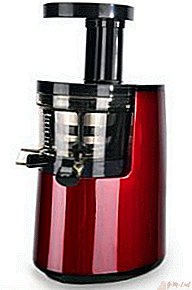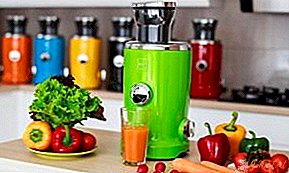 A juicer is a great helper for making fresh, natural juice rich in vitamins. The acquisition of a juicer indicates first of all that a person takes care of his and the health of his loved ones. For this reason, it is necessary to choose a similar product carefully, having studied in detail all the necessary nuances. After all, the quality of the finished product depends not only on the ingredients used in the preparation process, but also on the device with which it was received.
A juicer is a great helper for making fresh, natural juice rich in vitamins. The acquisition of a juicer indicates first of all that a person takes care of his and the health of his loved ones. For this reason, it is necessary to choose a similar product carefully, having studied in detail all the necessary nuances. After all, the quality of the finished product depends not only on the ingredients used in the preparation process, but also on the device with which it was received.
What criteria should be considered when choosing a juicer for home
In the process of choosing this device, it is recommended to pay special attention to the following parameters:
- the presence of a special container for pulp;
- type of separator (can be cylindrical or conical);
- the presence of several speed modes;
- device power;
- the presence of a foam cutter (a very convenient addition, eliminating the additional filtering of the resulting juice);
- acceptable cyclicity and optimal duration of work (for example, 10 minutes can be used continuously, then you must definitely take a break of 1 minute);
- A detailed list of fruits and vegetables that can and cannot be squeezed in this unit.
IMPORTANT! The main requirement for any juicer is a clear compliance with the technical specifications stated in the instructions for use.
Gear shift function
 For different ingredients, various operating modes are provided. Certain models of such devices often have up to 9 speed modes. But in practice, 2-3 is quite enough. The lower the speed, the more transparent and pure juice, for example, from apples, will turn out. Some centrifugal models have only 1 mode. Such juicers cannot be used to make fresh fruits and vegetables that are relatively soft.
For different ingredients, various operating modes are provided. Certain models of such devices often have up to 9 speed modes. But in practice, 2-3 is quite enough. The lower the speed, the more transparent and pure juice, for example, from apples, will turn out. Some centrifugal models have only 1 mode. Such juicers cannot be used to make fresh fruits and vegetables that are relatively soft.
Acceleration speed
For the quickest possible squeezing of the finished product, a centrifugal model with a speed of 8000-10000 revolutions per minute is better. At lower speeds, the device will function more slowly and, accordingly, consume more energy. Too high speeds only slightly increase the efficiency of the device. Electricity is also consumed in excessive quantities. Citrus juicers and screw machines have relatively low speeds.
Power
HThe higher this indicator, the faster and better the device will produce juice. Models designed for citrus have a power of 20 to 80 watts. This is enough to get fresh from a lemon or a juicy orange. For centrifugal devices, a characteristic power is from 250 to 300 watts. In this case, the speed of rotation of the separator reaches 10,000-12,000 rpm. Indicators of screw devices vary in the range from 150 to 250 watts. If the centrifuge speed is high, the finished product will contain a larger volume of pulp.
Acquiring a device with excessively high characteristics (up to 23,000 rpm) does not make much sense, since this factor has almost no effect on the quality of the finished product and the performance of the device.
Production material
 The case of such a device is made of aluminum, plastic or stainless steel. Juicers with a metal casing are more reliable than plastic ones and have a more spectacular appearance. But at the same time they are heavier and their cost is higher. Plastic models have a more affordable price. In addition, caring for them is easier. With careful handling, a plastic juicer will work properly for many years.
The case of such a device is made of aluminum, plastic or stainless steel. Juicers with a metal casing are more reliable than plastic ones and have a more spectacular appearance. But at the same time they are heavier and their cost is higher. Plastic models have a more affordable price. In addition, caring for them is easier. With careful handling, a plastic juicer will work properly for many years.
Every detail of such a device must be durable and of high quality. The centrifuge in centrifugal type models is in all cases made of stainless steel. Augers and citrus juicers may have plastic filter components. This is explained by a less significant load on them due to the low rotation speeds.
IMPORTANT! Fingerprints are clearly imprinted on glossy black plastic and polished stainless steel.
Additional features
Before choosing a specific juicer model, you need to decide if you need any additional features. Models with many different functions have a higher cost, but they also produce juice faster and better.
The main additional features include:
- drop-stop function (if, after turning off the juicer, lift or turn the spout, the last drops of squeezed juice will not get on the table);
- rubberized legs or legs on suction cups, providing additional stability;
- automatic ejection of pulp;
- special compartment for cleaning the cord;
- smooth engine start.
Such opportunities allow you to make the process of obtaining juice more enjoyable, faster and more comfortable.
What juicers are
To date, the range of juicers is represented by screw and centrifugal models. How to figure it out: which one is better?
Screw screws - principle of operation, pros and cons
They operate according to the principle of a meat grinder: berries are fed into a special compartment, where they are subsequently ground. The main component of such a device is a conical spiral screw operating at low speeds. There are models with horizontal or vertical placement of the screw. They can be manual, horizontal single-screw, horizontal twin-screw or vertical.
Benefits:
- during processing, the maximum of useful substances of the products used is preserved;

- you can stock up on billets and store the juice in the refrigerator for two days without deteriorating its nutritional properties;
- a better extraction of the ingredients is carried out, so more juice is obtained than in centrifugal devices;
- You can successfully get juice even from seeds, herbs and nuts;
- 1.5-2 times less foam is released during operation compared to centrifugal devices;
- the device works almost silently.
Disadvantages:
- high price;
- limited range;
- the juice turns out to be quite thick, similar to mashed potatoes or baby food, which is not suitable for everyone.
REFERENCE! It will be an excellent option for vegetarians, adherents of raw food diet, families with small children and those who need ground diet food.
Centrifugal - principle of operation, pros and cons
The most popular type of juicer. The main element of this unit is a separator - a saucer with small cloves and holes of a conical or cylindrical shape, made of metal. Initially, the grinding of fruits in such devices is carried out using a grater. After this, the feed is in a separator, where the juice is separated from the pulp under the influence of centrifugal force.
Devices of this type are divided into two types:
- Models with a cylindrical separator - the juicers belonging to this type provide a larger amount of juice, but they do not have the ability to automatically reject the cake. Such devices become clogged quickly enough, after which they must be disassembled and washed by hand.

- Conical separator models. Waste accumulates in a tank specially designed for this purpose, which is easily removable. But the power of such devices is much lower.
Benefits:
- affordability;
- diverse assortment;
- universality (they can easily cope with almost any product);
- ease of use (small fruits can be immersed in the entire cylindrical hatch, thereby saving time);
- Compared with a screw juicer, juice is squeezed 2-4 times faster.
Disadvantages:
- a large amount of foam is formed;
- juice is squeezed less thoroughly when compared with a screw juicer;
- the action of centrifugal force provokes the rapid oxidation of the juice, which negatively affects its taste;
- the device makes a lot of noise during operation;
- cannot be used for solid products;
- quite tall models that take up a lot of space.
This unit should be chosen if the main necessary function is the speed of obtaining the finished product. Also, such a device is useful in the manufacture of juices from soft and juicy fruits and vegetables.
ATTENTION! The more compact the device, the less likely it will subsequently have to gather dust on the mezzanine.
Using a juicer will be more pleasant and easier if it has such useful little things:
- a pusher for products that facilitates the process of loading ingredients into the neck of the device;
- wide diameter of a loading mouth;
- safe mode - if the device is not assembled correctly, it simply will not turn on;
- removable waste collection tank.
There are a huge variety of models of juicers. Before acquiring such a device, you need to correctly determine its main purpose. It is also necessary to take into account the availability of free space in the kitchen so that the juicer can fit harmoniously into the surrounding space.



Leave Your Comment